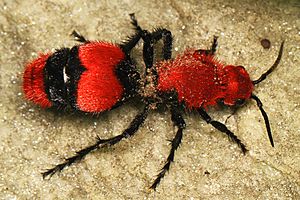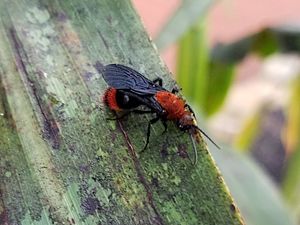Red velvet ant facts for kids
Quick facts for kids Red velvet ant |
|
|---|---|
 |
|
| Female | |
 |
|
| Male | |
| Scientific classification |
The red velvet ant (also known as the eastern velvet ant, cow ant, or cow killer) is a type of parasitoid wasp found in the eastern United States. Even though it's called an "ant," it's actually a wasp! This is because the female red velvet ant doesn't have wings, making her look a lot like a large, fuzzy ant. You can find these interesting insects from Connecticut to Missouri in the north, and from Florida to Texas in the south.
The eastern velvet ant is the biggest velvet ant species in the eastern U.S., growing to about 0.75 inches (1.9 cm) long. Adults have special warning colors (called aposematic coloration). They are mostly black with bright orange-red patterns on their back and belly. They are covered in thick, soft hair that looks like velvet.
Contents
What is a Red Velvet Ant?
Many people think the red velvet ant is a true ant because of its look and common name. However, it is actually a type of parasitoid wasp. The female red velvet ants do not have wings. This is why they crawl on the ground and look so much like ants.
You can easily spot them by their black and orange-red stripes. Female red velvet ants can deliver a very painful sting. This is how they got the nickname "cow killer." They move quickly and often get into a defensive pose if they feel threatened. Unlike the females, male red velvet ants have dark, see-through wings and do not have a stinger. Both male and female red velvet ants can make a squeaking noise. This sound, called stridulation, helps them warn away animals that might try to eat them.
Where Do Red Velvet Ants Live?
Red velvet ants prefer dry, sandy places. You can find them in fields, forests, and grasslands. They mostly live in the southeastern United States.
What Do Red Velvet Ants Eat?
Adult female red velvet ants enjoy eating the sweet nectar from flowers. This gives them the energy they need to live and have babies. However, the larvae (baby red velvet ants) have a very different diet. They are parasitic. This means they depend on other insects to survive.
Female red velvet ants lay their eggs near or inside the nests of other insects. These often include bees or other wasps. Once the eggs hatch, the tiny larvae eat the host insect's larvae or pupae. This is a cool example of how insects can have different lifestyles at different stages of their lives.
How Do Red Velvet Ants Defend Themselves?
The velvet ant has many ways to protect itself. It is most famous for its extremely painful sting. This sting is why it earned the nickname "cow killer." But don't worry, they cannot actually kill a cow!
Their defenses include:
- A very tough outer shell (exoskeleton).
- The ability to run very fast and dodge danger.
- Bright warning colors to tell predators they are dangerous.
- Squeaking warning sounds (stridulation).
- A special chemical they can release.
- Venom from their sting.
Reproduction and Life Cycle
Like most wasp species, velvet ants live alone. Male velvet ants fly around to find females. They can smell special chemicals (pheromones) released by females. Males also fly towards the squeaking sounds made by females.
Once a male finds a female ready to mate, he will pick her up with his mouthparts. He then carries her to a safe, shady spot away from other males. Both males and females make squeaking sounds during mating. After mating, the female starts looking for the eggs and larvae of other insects. Females are thought to mate only once in their lives.
After mating, females search for the nests of insects like Eastern cicada killers and horse guard wasps. They also look for other large wasps that nest in the ground. The female velvet ant sneaks into the host's nest. She then lays one of her eggs onto a host larva. The egg quickly hatches into a white, legless grub. This grub then eats the host larva. It goes through several stages before becoming a pupa. The pupa stage usually lasts about 23 days.
Interesting Facts About the Red Velvet Ant
- They are called "cow killers" because their sting is incredibly painful. But they cannot actually kill cows!
- Only female red velvet ants can sting. Males do not have stingers.
- Their sting is considered one of the most painful among insects. It even ranks high on the Schmidt Sting Pain Index.
- Even with their painful sting, they are not aggressive. They will only sting if you handle them or accidentally step on them.
Scientific Classification

